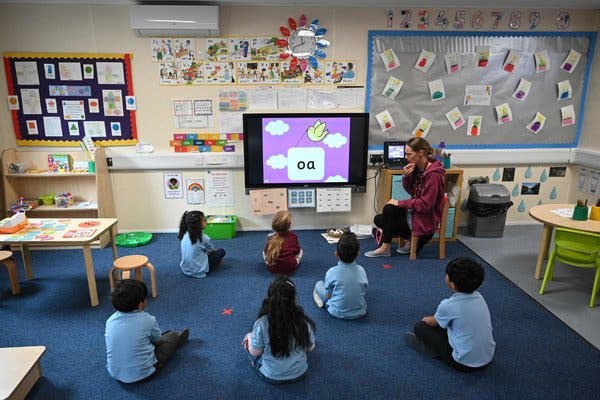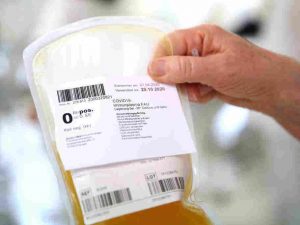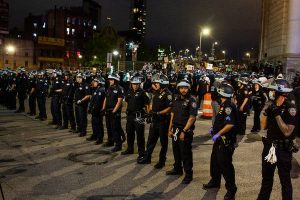Here’s what you need to know:
- Smaller classes, masks, slashed budgets: Educators look toward an altered landscape.
- New U.S. jobless claims are expected to reflect continuing layoffs, even as reopening proceeds.
- New York drugmaker is set to begin a clinical trial of an antibody treatment.
- Increased voting by mail this spring offers lessons for November.
- Europe reopens to a mix of the familiar and the alien.
- China has pushed for more street vendors, suggesting its post-virus recovery may not be all that it seems.
Smaller classes, masks, slashed budgets: Educators look toward an altered landscape.
Across the United States, school leaders are beginning to roll out plans to welcome more than 50 million students back in the fall, including procuring millions of masks; flooding schools with nurses, aides and counselors; and staggering schedules to minimize class size.
But the high-dollar demands to meet public health guidelines and make up for setbacks that have disproportionately affected low-income students, students of color and those with disabilities could cripple some schools’ budgets.
On Wednesday, educators told a Senate panel that without a large federal investment in public schools, districts hit hard by the virus will struggle to meet the needs of their pupils this fall as they try to reopen.
Around the world, schools are trying to manage the risks and rewards of having students back in classrooms. This week, Britain abandoned plans to have primary school pupils return before the summer holidays because of the difficulty of social distancing and the reluctance of parents to send their children back. Unlike many schools in the U.S., schools in Britain had remained open during its lockdown for vulnerable students and those whose parents are essential workers.
In other places, though, students have returned. In the Netherlands, all elementary schools opened on Monday. Social distancing is not required for children in day care and elementary schools — and they are not required to wear masks — but they must wash their hands often. Outdoor play is done with a consistent group of children, and after school everyone has to leave the premises immediately. Parents are not allowed to gather inside the school or on the school’s playground. At Dutch high schools, which opened last week, social distancing is required.
Some schools in Spain, which was among the hardest-hit countries in Europe, opened late last month, but the return to class is patchwork as public schools are controlled by 17 regional governments.
Schools in Hong Kong began to reopen on May 27 for half-day classes after being closed since February. Students, teachers and visitors are required to wear masks, sanitize their hands and have their temperature checked upon arrival.
It is impossible to know what the time away from school will mean for children, but some studies paint a bleak picture. As our reporter Dana Goldstein wrote last week, new research suggests that by September, most students in the United States will have fallen behind where they would have been if they had stayed in classrooms, with some losing the equivalent of a full school year’s worth of academic gains.
And to do any of what needs to be done to reopen, schools need money. At the Senate hearing on Wednesday, Susana Cordova, the superintendent of Denver Public Schools, told senators, “At a time when our kids and our communities need us most, we are having to make massive cuts.” Additional funding would be essential, she said: “We must double down for those who have been most impacted by the Covid crisis if we are to deliver on the promise of education to create a more equitable society.”
New U.S. jobless claims are expected to reflect continuing layoffs, even as reopening proceeds.
Another huge weekly batch of new unemployment claims is expected to be reported on Thursday by the Labor Department.
Economists surveyed by Bloomberg estimated that 1.6 million people filed initial claims for state unemployment insurance last week. That would continue the decline from the more than six million claims seen in a single week in March, but would still be an unusually high number.
More than 40 million state claims have been filed since the coronavirus pandemic caused a widespread shutdown of businesses, and 21.5 million jobless workers were collecting state benefits in the previous weekly report. Some of those ineligible for state benefits, like the self-employed, are getting aid under an emergency federal program.
“We’re slowly seeing the labor market recovery begin to take form,” said Robert Rosener, an economist at Morgan Stanley, but “there’s still an enormous amount of layoffs going on.”
In its first economic projections this year, the Federal Reserve on Wednesday said that it expected the unemployment rate to end 2020 at 9.3 percent and remain elevated for some time, coming in at 5.5 percent in 2022. That would be far above the historically low jobless rates that preceded the virus.
New York drugmaker is set to begin a clinical trial of an antibody treatment.
The drugmaker Regeneron said on Thursday that it was beginning a clinical trial of an antibody cocktail that it has developed to prevent and treat Covid-19, the disease caused by the coronavirus.
Regeneron, which is based in Tarrytown, N.Y., is one of a handful of companies trying to develop treatments that work similarly to the antibodies that people develop naturally when they contract the virus. If the treatments work, they might provide a bridge to a vaccine, and possibly a temporary protection to people like health care workers who are at high risk of becoming infected.
The company said it would begin testing its product in four groups: patients who are hospitalized with Covid-19; those who are infected and have symptoms but are not hospitalized; groups that are at high risk of being infected, like health care workers; people who have been exposed to someone with Covid-19.
Regeneron developed the antibody treatment using specially designed mice that have human immune systems, as well as by isolating antibodies from people who have recovered from Covid-19. The researchers selected two of the most potent antibodies and then scaled them up for testing. A similar approach was used by Regeneron in an antibody treatment that was shown to work with Ebola patients.
“We hope to see similar success with this program and help improve outcomes against this terrible disease,” Christos Kyratsous, a vice president at Regeneron, said in a statement.
Drug trials are highly unpredictable, even if they have shown early promise in the lab. Still, the company has said that if the cocktail is successful, it could be ready to produce thousands of doses for preventative use by the end of the summer, before vaccines are available.
Other companies working on antibody treatments include Eli Lilly, which recently began early-stage trials of its treatment, and Vir Biotechnology, which is working in partnership with GlaxoSmithKline.
Increased voting by mail this spring offers lessons for November.
The elections held around the United States during the pandemic have revealed a mixed picture as different states experienced huge increases in voting by mail.
The good news: The rapid expansion of voting by mail over the past few months allowed millions of people to vote without risking their health. During the pandemic, turnout in the 15 states that have held elections, and Washington, D.C., was high, and in some cases at near-record levels, even after former Vice President Joseph R. Biden had all but secured the Democratic presidential nomination.
The bad news: A host of infrastructure and logistical issues might have cost thousands of Americans their opportunities to vote. There have been complaints of ballots lost in the mail; of some ballots printed on the wrong paper, with the wrong date or the wrong language; and of some that arrived late or not at all.
Absent from any reported issues in the states, however, were indications of widespread fraud. President Trump has repeatedly made false arguments suggesting that voting by mail is riddled with fraud.
But the most definitive lesson for the election in November may be the strong possibility that many states, including key battlegrounds, will not finish counting ballots on election night.
Europe reopens to a mix of the familiar and the alien.
A reporter and a photojournalist for The New York Times recently spent two weeks documenting Europe’s emergence from a monthslong lockdown. They drove through six countries, trying to capture a world that teetered on the lip of normality and often toppled into the surreal.
At a parking lot in Prague, a group of actors prepared a stage set — but then performed to an audience of cars.
In Schüttorf, a small German town near the Dutch border, a nightclub hosted guests. But the clubbers had to stay in their cars. They were allowed outside only to visit the bathroom.
In an industrial wasteland in northern Copenhagen, a family of churchgoers said their prayers from the comfort of their car, as their pastor preached to them in a parking lot.
But the longer the pair traveled, the faster Europe seemed to accelerate toward normalcy. Cars were back jamming the streets. Chatter was returning to the classrooms. Families were beginning to meet again.
Across the continent, Europeans were gradually adapting to the new reality. The normal felt almost normal again.
China has pushed for more street vendors, suggesting its post-virus recovery may not be all that it seems.
Xie Yiyi, who is American-educated, lost her job last Friday, making the 22-year-old Beijing resident one of millions of young people in China left unmoored and shaken by the coronavirus.
So that same day, heeding the advice of one of China’s top leaders, she decided to open a barbecue stall.
Street vendors are seen by many Chinese people as embarrassing eyesores from the country’s past, when it was still emerging from extreme poverty. In many Chinese cities, uniformed neighborhood rules enforcers called chengguan regularly evict and assault sidewalk sellers of fake jewelry, cheap clothes and spicy snacks.
But Li Keqiang, China’s premier, has publicly called for the country’s jobless to ignite a “stall economy” to get the country’s derailed economy back on track. In the process, he laid bare China’s diverging narratives after the coronavirus epidemic. Is China an increasingly middle-class country, represented by the skyscrapers and tech campuses in Beijing, Shanghai and Shenzhen? Or is much of it still poor and backward, a country of roadside stalls in back alleys?
Mr. Li’s comments defied the Communist Party’s usual narrative of untrammeled prosperity, which helped legitimize its rule.
Cities rushed to lure vendors to the streets. A few even set recruiting quotas for the chengguan, meaning that the people who once harassed and beat vendors now had to support them. An economist estimated that 50 million jobs could be created if the government gave more space to the vendors and farmers selling their produce.
But then a backlash began, and the state media began reining in the enthusiasm. “The stall economy isn’t appropriate for first-tier cities,” said China Central Television, the state broadcaster, referring to relatively wealthy cities like Beijing and Shanghai. Allowing the stall economy to make a comeback in those cities is “equivalent of going backward in decades overnight,” it wrote. “It’s a departure from high-quality growth.”
Reporting was contributed by Nick Corasaniti, Dana Goldstein, Erica L. Green, Tiffany Hsu, Patrick Kingsley, Raphael Minder, Claire Moses, Kaly Soto, Katie Thomas, Laetitia Vancon, Daniel Victor, Michael Wines and Li Yuan.




















